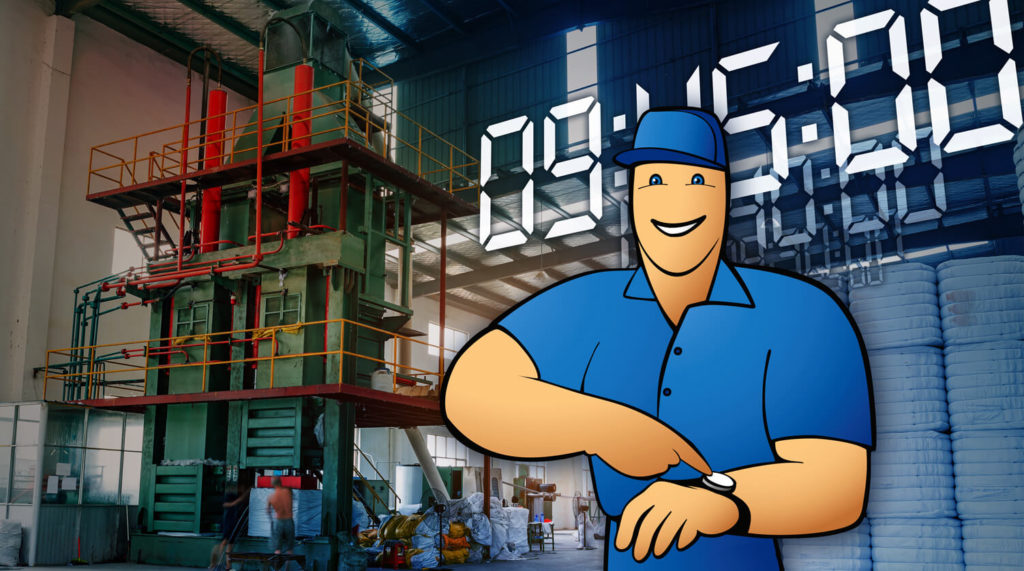Just-in-Time Manufacturing (JIT): Definitions, Benefits, Tips
Just-in-Time manufacturing helps businesses shorten lead times, minimize inventory, and address other hidden inefficiencies by aligning supplies directly with production schedules.

You can also listen to this article:
What is Just-in-Time manufacturing?
Just-in-time manufacturing, or JIT, is a production methodology designed to meet demand as exactly as possible while minimizing waste and extra costs associated with creating surplus goods. It is similar to lean manufacturing and the terms are sometimes used interchangeably.
Also known as short-cycle manufacturing, JIT aims to produce exactly what, when, and how much was ordered – either by the next workstation sequence or the customer. The just-in-time inventory model, on the other hand, aims to order goods so that they would arrive just in time for their consumption. Accurate demand forecasting is thus a prerequisite of this production and inventory model.
Although JIT grew out of the automotive industry and remains very popular there, the methodology can be implemented in practically any industry sector.
Just-in-Time manufacturing wastes
JIT is geared toward eliminating waste arising from inefficient manufacturing. This results in reduced standing inventory, labor costs, storage space, throughput time, etc. Let us take a look at the different types of manufacturing wastes that JIT addresses in a bit more detail. These are sometimes also called the 8 Wastes of Lean.
Overproduction is manufacturing products in advance of or more than the demand specifies. It’s considered to be the most severe of the wastes by proponents of just-in-time manufacturing because it squanders time, space, and money, all the while masking the other problems within a company’s processes.
Waiting to begin one process until another one finishes is ineffective and a colossal waste of time. The flow of all operations should be efficient and continuous. Some estimates claim that more than 90 percent of a product’s time in manufacturing is spent waiting.
Excess inventory typically means that a company has ordered more than the market demands or the demand falls dramatically after the inventory is ordered. Either way, it hurts business because it takes up space and must be managed. Companies often rid themselves of excess inventory by selling it at a reduced cost or tossing it out, either of which can lower profits significantly.
Unnecessary transportation of materials or products within the production process is also wasteful. JIT seeks to streamline material flow and eliminate inessential transportation steps or distances.
Excessive motion of people or equipment wastes time and energy. JIT focuses on optimizing layouts, workstations, and assembly lines to minimize wasted motion and improve ergonomics.
Overprocessing or performing unnecessary or excessive steps in the production process adds no value to the final product. JIT aims to eliminate non-value-added activities, streamline processes, and focus on value-adding steps.
Errors or defects that require rework, repair, or scrap are one of the most glaring examples of waste. JIT emphasizes quality control and defect prevention to reduce the occurrence of defects, improving overall efficiency and customer satisfaction.
By addressing and minimizing these wastes, JIT aims to create lean and efficient manufacturing processes, optimize resource utilization, enhance productivity, and improve overall operational performance.
History of Just-in-Time manufacturing
Just-in-time manufacturing began in earnest after World War II. Cash-strapped Japanese manufacturers began adopting the system because they could not finance the large inventory production methods that developed countries were using. They also lacked natural resources and available employees to take on large-batch inventory production.
As a result, these manufacturers built smaller plants and quickly turned small amounts of raw materials into small batches of products or components. These smaller quantities allowed the manufacturers to generate maintainable levels of working capital while minimizing their financial risk.
While the original just-in-time concept is credited to Taiichi Ohno of Toyota (it was even called the Toyota Production System or TPS in Western media), some argue that Japan’s shipyards successfully developed and implemented the approach first. No matter which of these was the originator, the idea was born from Japan’s post-war lack of cash, lack of space for large factories and inventory, and their lack of natural resources.
News of the just-in-time manufacturing technique reached the United States around 1977, and by 1980 most of the developed countries had implemented some version of it.
Just-in-Time manufacturing vs. traditional methods
In the past, manufacturers carried larger inventories of raw materials and produced larger quantities of finished goods just in case there was an increased demand for their products. Not surprisingly, that philosophy is often called just-in-case manufacturing (JIC). Companies referred to this extra inventory as safety stock and it forced them to manage this excess inventory and absorb a dent in their profits.
Just-in-time manufacturing, however, aims to order smaller quantities of raw materials more frequently, just as they are needed for short-term production. Likewise, goods are manufactured only when a signal is received from upstream of the supply chain. Ordering materials or initiating production in a pull system where goods are fed into the system as needed means a business operates with low inventory levels at all times and does not hold safety stock. The just-in-time manufacturing strategy thereby lowers or eliminates their costs to carry excess inventory, while also decreasing waste.
Just-in-Time vs. continuous flow
Although JIT and continuous flow both are geared toward eliminating waste and the two methodologies are often conflated, the differences are clear. While just-in-time focuses on minimizing inventory and lead times by producing goods precisely when needed, continuous flow is based on the uninterrupted flow of materials and work to achieve maximum efficiency, often in high-volume standardized production. JIT utilizes pull-based systems and demand-driven replenishment, while continuous flow aims for a steady flow of work with minimal changeovers. JIT enables quick transitions between products, while continuous flow seeks to maximize equipment utilization. Both approaches aim to eliminate waste and improve efficiency but with different emphases on inventory management, production philosophy, and equipment utilization.
When to use Just-in-Time?
Just-in-time manufacturing is the almost natural state of business for make-to-order manufacturers, e.g. if you engineer to order or run a small job shop. However, the idea of JIT is to bring the advantages of those manufacturing modes to larger-scale manufacturing.
The core ideas of JIT in manufacturing are that on end, the materials for production should arrive exactly when production is scheduled to begin, and not any earlier. And on the other end, the manufactured products should be finished just about when they should be delivered to customers.
This means that JIT could be used best when the market demand for the products can be forecasted with high accuracy, demand is without sudden fluctuations, and when you have highly reliable vendors.
Just-in-Time manufacturing advantages
When companies put the proper time and effort into implementing a just-in-time manufacturing system, they can expect to see a sweeping impact on their productivity, risk management, and operating costs. Here are some of the benefits that JIT manufacturers worldwide are experiencing:
- Drastically reduced inventory levels. JIT manufacturing focuses on producing goods only as they are needed, minimizing the need for large inventory stocks. This leads to reduced carrying costs, such as for storage, handling, and obsolescence.
- Shorter lead times. By aligning production closely with customer demand, JIT manufacturing reduces the time required to produce and deliver products. This enables companies to respond quickly to changing market conditions and customer preferences.
- Reduced labor costs. JIT manufacturing emphasizes efficient production processes, which can lead to reduced labor costs. By eliminating waste and streamlining operations, companies can optimize labor utilization and reduce unnecessary labor expenses.
- Less space needed to operate. Since JIT manufacturing aims to minimize inventory and work-in-process, less space is required for storage and production. This can result in cost savings related to facility rental or ownership, as well as improved space utilization.
- Reduction in work-in-process inventory (WIP). JIT manufacturing aims to minimize the amount of work-in-process inventory, which includes unfinished products or components in the production process. This reduces the tied-up capital and improves cash flow.
- Better quality management. JIT manufacturing relies on tight quality control and emphasizes defect prevention. By focusing on eliminating waste and improving processes, companies can reduce defects and improve overall product quality.
- Reduction in throughput times. JIT manufacturing seeks to streamline production processes, resulting in reduced throughput times. This means that products move through the production system more quickly, allowing for faster delivery to customers.
- Fewer standard hours. JIT manufacturing focuses on the efficient use of resources and reducing non-value-added activities. This can lead to a reduction in standard hours required to produce goods, resulting in cost savings.
- Increased number of shipments. JIT manufacturing encourages frequent, smaller shipments to match customer demand. This can result in increased customer satisfaction and more responsive delivery schedules.
The inventory reduction brought on by a JIT system could also unveil an array of problems and inefficiencies that were previously masked with high inventory levels. These may include frequent breakdowns, long set-ups, ineffective scheduling, skills shortages, etc. All in all, the JIT production model has the potential to greatly reduce your production costs and elevate you to a higher level of production efficiency.
Just-in-Time manufacturing risks
For the most part, businesses that employ just-in-time manufacturing practices will see lower inventory levels, reduced cycle times, faster times to market, and reduced operating costs. But there are risks, especially for smaller companies. One supplier that experiences a breakdown and can’t deliver the materials that a company needs can disrupt or shut down the entire production process.
Additionally, a customer’s orders for products could exceed the company’s forecasted expectations, which could delay the shipment of finished goods to several customers.
To have the best chance of success with just-in-time, it’s critical that companies find suppliers that are either located close by or can supply materials quickly and with little advanced notice. It’s also important that these suppliers waive any minimum order requirements that could hurt smaller businesses, which typically purchase smaller quantities of materials.
JIT implementation tips
Just-in-time manufacturing leans heavily on supplier relationships, communication, standardization, and continuous improvement. That is why some businesses, especially smaller ones, often struggle with implementing the system.
1. Create strong supplier relationships
For one, larger companies have an advantage over SMEs due to their sheer size – as they make up a large portion of a supplier’s business, they easily achieve priority status. And when issues occur in the supply chain, smaller clients are neglected in favor of the larger ones. With just-in-time manufacturing, however, this kind of disruption could derail the whole operation as the business depends on its suppliers and does not keep any safety stock. That is why managing supplier relationships is key to just-in-time manufacturing. Another way to mitigate this problem would be to select suppliers that are physically close to your facility.
2. Ensure effective internal communication
Internal communication could prove to be an issue as well. When information pertaining to the operation is siloed, i.e. every department has separate data systems, communication suffers. That in turn slows down the whole operation, causes data inaccuracies, and could have a significant effect on the bottom line of the company. For just-in-time manufacturing to work, a customer order should reach the planning department just as the sales representative enters it into their system. And that requires a centralized data system such as an ERP/MRP system.
3. Standardize processes
Having standard procedures in place for every operation ensures that the outcomes are reliably predictable. That includes how long the procedure should take and what quality items it should produce. When a deviation from the norm is detected, measures can be taken to identify the cause of the inconsistency.
4. Reduce lot sizes
Working in smaller lots has many advantages, including better quality, less work-in-process inventory, and a reduction in inventory costs and required storage space. As for just-in-time manufacturing, smaller lots mean that only the immediately required amount of goods is produced, and nothing is made to stock.
5. Increase workflow efficiency
In addition to standardizing the procedures and working with smaller lots, a just-in-time manufacturer has to have a well-planned facility layout that would support the production flow. This can be created with an approach called cellular manufacturing, wherein equipment, parts bins, tools, and workstations are arranged in cells to accommodate optimized manufacturing processes, reducing set-up and changeover times, and ensuring a streamlined movement of materials.
6. Keep inventory under control
Good inventory control is crucial for Just-in-Time manufacturing as it enables lean operations, minimizes waste, reduces costs, and enhances responsiveness. It ensures optimal inventory levels aligned with production needs, reduces lead times, and improves flexibility. Effective inventory control identifies bottlenecks and inefficiencies, supports quality control efforts, and strengthens supplier relationships. It is a prerequisite for JIT’s success as it facilitates the efficient flow of materials, contributing to improved efficiency and customer satisfaction.
7. Implement backward scheduling
Backward scheduling means that production orders are scheduled precisely so they would be finished and promptly delivered by the clients’ requested delivery dates. That means everything is scheduled for the last minute, including the ordering of the materials and the production itself. This, however, cannot be manually done on a consistent basis and requires an ERP/MRP system with a backward scheduling functionality.
Just-in-Time manufacturing with a cloud-based ERP/MRP system
Not only can just-in-time manufacturing work alongside an ERP/MRP system, software could play an integral part in the JIT approach. Aligning with the goals of just-in-time, manufacturing operations management systems have been designed to trim the extra fat from a business, streamline operations, and ensure efficient resource planning and utilization. Here is how a manufacturing ERP system can help you implement JIT:
- Inventory management. JIT manufacturing aims to minimize inventory levels while ensuring materials and components are available when needed. An ERP system enables real-time visibility into inventory levels, tracks material usage, and triggers reorder point notifications for timely replenishment.
- Production scheduling and control. Manufacturing ERP systems provide comprehensive production scheduling tools, allowing manufacturers to create efficient production plans that align with customer demand. The system considers factors such as available capacity, material availability, and order priorities to optimize the production schedule. By using backward scheduling, an ERP/MRP system can seamlessly schedule an order so that it would be finished right when it should be dispatched.
- Supplier management. An ERP system with robust supplier management capabilities helps streamline communication, collaboration, and coordination with suppliers. It facilitates just-in-time deliveries by providing visibility into supplier performance, managing purchase orders, and integrating supplier information into the production planning process.
- Real-time data and analytics. ERP systems capture real-time data from various stages of the production process, including inventory, production lines, and quality control. This data can be analyzed to identify bottlenecks, track manufacturing metrics, and drive continuous improvement efforts.
- Quality control and assurance. An ERP system can incorporate quality management modules to track and manage quality processes, perform inspections, manage non-conformances, and facilitate corrective actions.
- Collaboration and communication. Effective communication and collaboration among different departments, such as production, purchasing, and logistics, are crucial for successful JIT implementation. An ERP system provides a centralized platform where stakeholders can access and share real-time information, improving coordination and responsiveness.
- Traceability and compliance. JIT manufacturing requires visibility and traceability of materials and components throughout the supply chain. An ERP system can track and record the movement of materials, enabling manufacturers to comply with regulatory requirements and recall products if necessary.
- Continuous improvement. MRP/ERP systems can support kaizen principles and continuous improvement initiatives by providing tools for data analysis, performance measurement, and identifying opportunities for waste reduction and process optimization.
- Automation. A manufacturing ERP system automates an array of administrative and clerical tasks, allowing you to allocate these resources to more vital areas of the business.
By providing a centralized data system and effortless and accurate communication between departments, an ERP system creates a basis for the implementation of JIT. As each data entry is reflected throughout the software, all departments instantly receive the necessary information for successfully executing the company’s JIT strategy.
Key takeaways
- Just-in-Time (JIT) manufacturing is a production methodology that aims to meet demand precisely while minimizing waste and extra costs associated with surplus goods.
- JIT focuses on producing exactly what, when, and how much was ordered, either by the next workstation sequence or the customer.
- The approach combats the seven types of manufacturing waste: overproduction, waiting, excess inventory, unnecessary transportation, excessive motion, overprocessing, and defects.
- JIT differs from traditional production methods by emphasizing inventory minimization, demand-driven production, shorter lead times, smaller batch sizes, and production flexibility.
- The model offers benefits such as reduced inventory levels, shorter lead times, lower labor costs, space efficiency, improved quality management, and increased customer satisfaction.
- Implementing JIT requires strong supplier relationships, effective internal communication, standardized processes, working in smaller lots, efficient workflows, good inventory control, and backward scheduling capability.
- JIT manufacturing can lead to reduced costs, improved efficiency, and enhanced competitiveness when implemented effectively alongside an ERP system.
Frequently asked questions
An example of a just-in-time manufacturing business is Toyota, which produces automobiles using the JIT manufacturing approach.
Lean manufacturing is a broader philosophy that focuses on minimizing waste and maximizing value, while just-in-time manufacturing is a specific strategy within lean manufacturing that aims to produce and deliver products exactly when needed to minimize inventory and associated costs.
You may also like: What Is Vendor-Managed Inventory and How to Use It?




